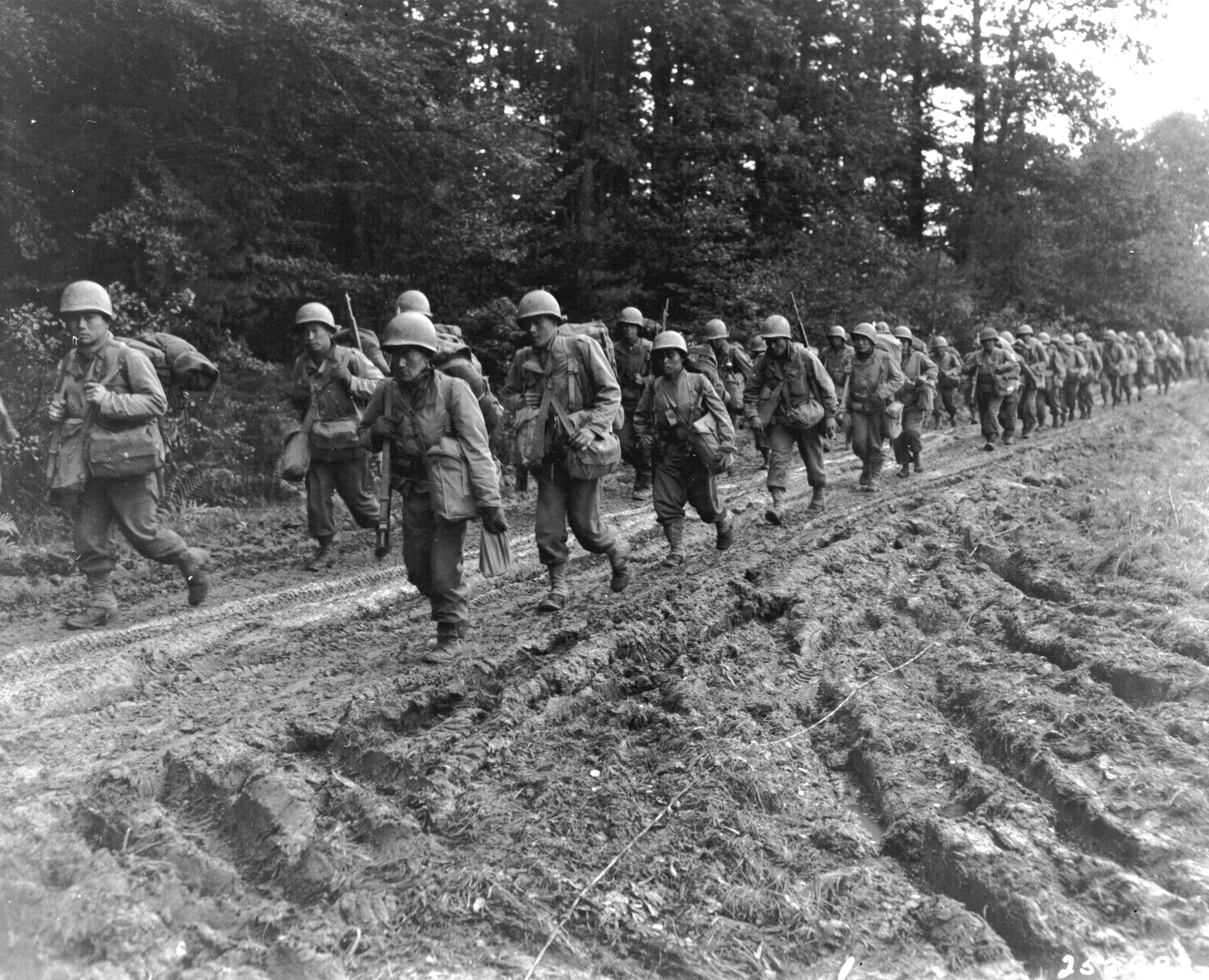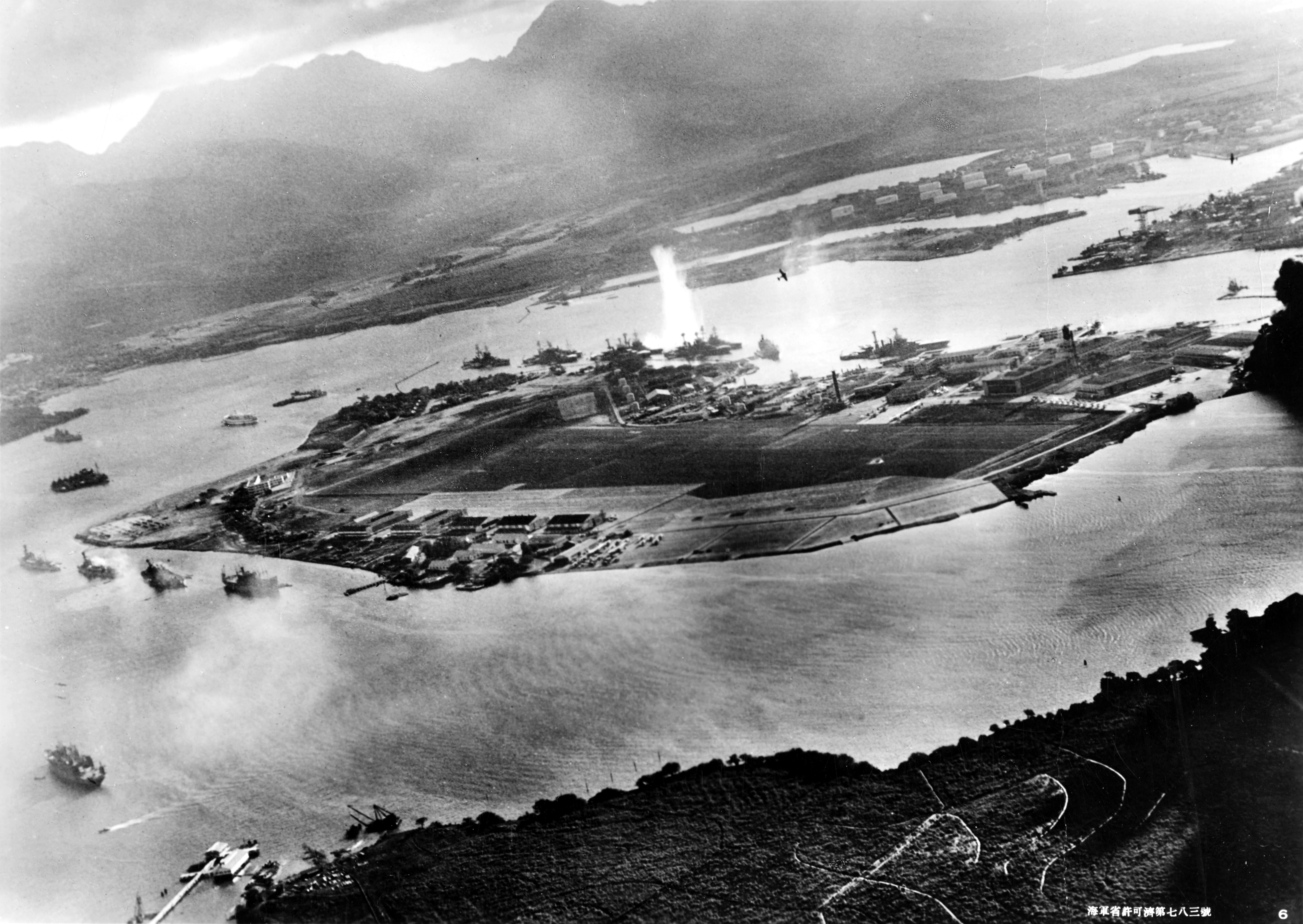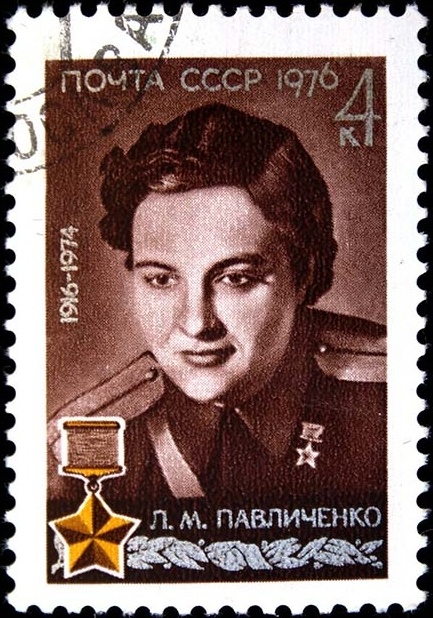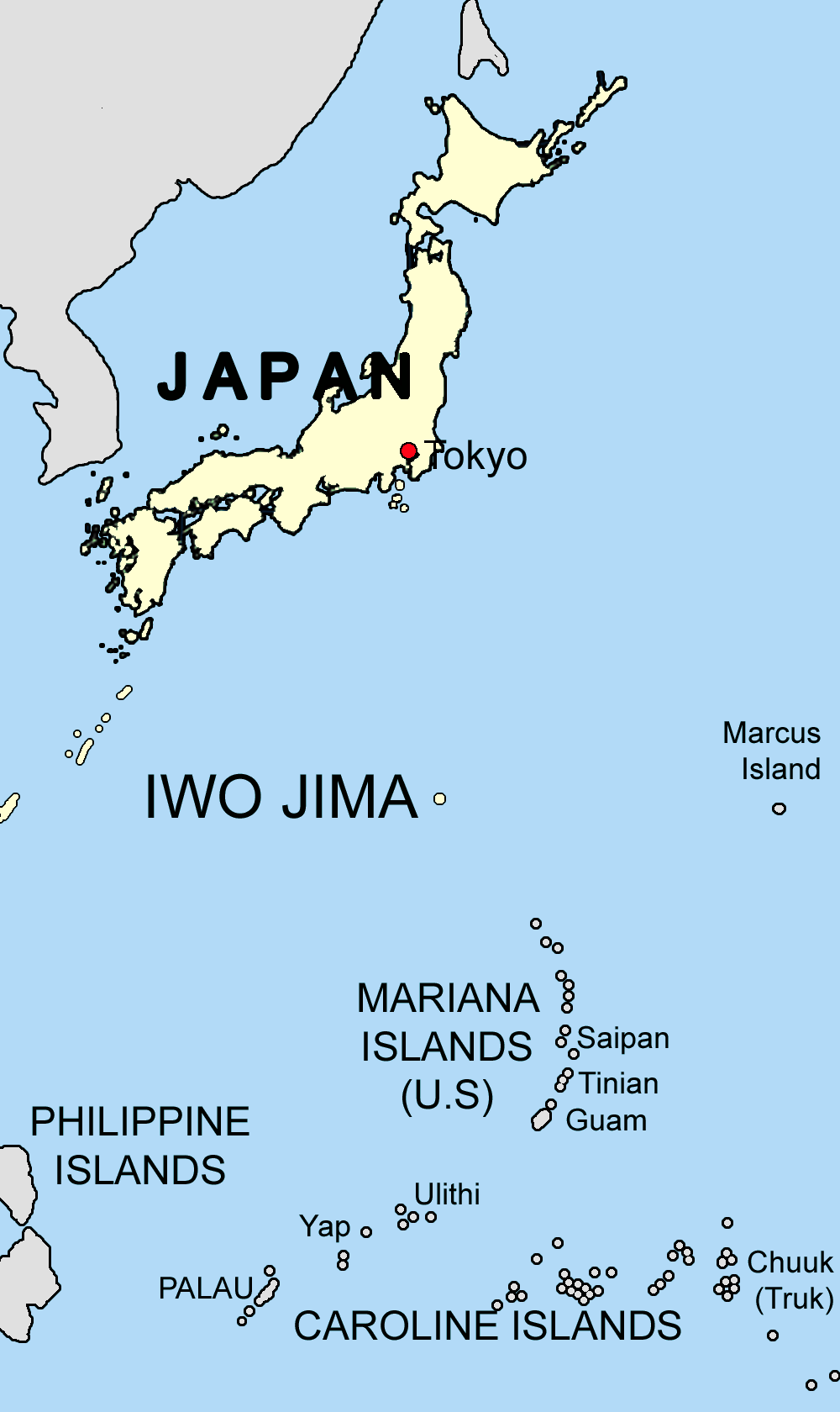
Battlefield memorial near Krojanty, northern Poland
Topics on the Page
Teaching Resources and Primary Sources
Japanese American Soldiers in World War II
African American Soldiers in World War II
Women Soldiers in World War II
- This article highlights 5 women who fought in WWII and their significance.
 Key Battles Listed in the Massachusetts Standards
Key Battles Listed in the Massachusetts Standards
A. German Conquest of Continental Europe
B. Battle of Britain
C. Pearl Harbor
D. Bataan Death March
E. El Alamein
F. Midway
G. Stalingrad
H. D-Day
I. Battle of the Bulge
J. Iwo Jima
K. Okinawa
L. Battle of Berlin
 Teaching Resources and Primary Sources
Teaching Resources and Primary Sources
 Command the U-505 Take command of U-505 and learn more about the life and operations on board a U-Boat in the second World War.
Command the U-505 Take command of U-505 and learn more about the life and operations on board a U-Boat in the second World War.
Click here for an interactive timeline of the major battles in World War II.
For information and a presentation with videos: Copy of Major Battles of WWII.
Japanese-American infantrymen, 442nd Regimental Combat Team, France, 1944

Japanese American Soldiers in World War II
While their families were interned in camps at home, the 100th Infantry Battalion and the 442nd Infantry Regiment, both composed mainly of Nisei — American born children of Japanese immigrants — fought for the allies in the Western Front of World War II.
Japanese Americans in Military during WWII
Japanese Americans at War, National Park Service
The Nisei Soldiers of World War II
Kazuo Yamaguchi: A Nisei Soldier of World War II
Multimedia Resources
 Crash Course offers these three videos on the history of the Second World War:
Crash Course offers these three videos on the history of the Second World War:
1. World War II Part 1
2. World War II Part 2
3. World War II: World History
Click here for the Discovery Channel's Flashpoints of WWII.
 Map Resources
Map Resources
Link here for an interactive map of the world during WWII from the History Channel.
- Link here for an interactive map of the spread of WWII.
- ABC offers an interactive map that shows territorial control as well as major events of the war by year.
Link here for World War II Historical Imagery from Google Earth 5.0, including images from the cities of Warsaw (Poland), Stuttgart (Germany), Naples (Italy), and Lyon (France).
 The Pacific and Adjacent Theaters in World War II, a photo blog from the Denver Post with photos from the attack on Pearl Harbor through Iwo Jima, the two atomic bombs, and the end of the war.
The Pacific and Adjacent Theaters in World War II, a photo blog from the Denver Post with photos from the attack on Pearl Harbor through Iwo Jima, the two atomic bombs, and the end of the war.
 Japanese Sign Final Surrender shows actual footage of the surrender ceremony of Japanese leaders to General McArthur in Toyoko Bay, September 1945.
Japanese Sign Final Surrender shows actual footage of the surrender ceremony of Japanese leaders to General McArthur in Toyoko Bay, September 1945.
 Click here for a lesson plan on Winston Churchill's wartime speeches.
Click here for a lesson plan on Winston Churchill's wartime speeches.
Focus Question: What were the key battles and events of World War II?
A. The German conquest of continental Europe
 |
| German Tanks, June 1940 in the Netherlands |
- Hitler began his occupation of Europe in March 1936.
- He would first "retake" the Rhineland which had be demilitarized.
- On September 1st, 1939 Hitler launched an invasion of Poland.
- In 1940 the countries of Norway and Denmark fell to the Nazis.
- He would also take France, Belgium, and the Netherlands in that year.
- After his occupation of France, the British and French troops organized Dunkirk Evacuation Dunkirk Evacuation to keep the army.
- Germany introduced a new military tactic termed Blitzkrieg or "lightning war" which was a coordination of the military tanks, infantry, and air force rapidly moving through the enemies lines causing confusion and capturing of strategic sites.
- Blitzkrieg was a response to the stalemated warfare of the World War I where no army made significant advances against the other.
- Germany had much success with this tactic because most of Europe continued to use World War I strategy which was ineffective against this new method of warfare.
Click here for a lesson plan based on the New York Times article on Nazi Germany invading Poland.
Click Here for information on the Molotov-Ribbentrop pact a non-aggression pact between Germany and the USSR that also contained plans to split the country between the two nations.
 |
| Bomb Damage in London during the Battle of Britain |
The Battle of Britain, an air assault, took place between September and August of 1940.
The Germans targeted British harbors, air and navel bases along with other key sites. The German Air Force, called the Luftwaffe, had more planes and were able to replace fallen pilots with greater speed as Hitler had been mobilizing the country longer.
However, the Germans lost more planes that the Royal Air Force (RAF) but for a long time the Germans had the strategic advantage of targeting radar bases.
Radar was pivotal for British victory in this battle and, eventually, the Germans were forced to abandon attempts to take control of the English Channel, preventing Hitler from invading Britain.
Part 1 (of a 3 part series) shows what was happening in Britain at the time of the German assault.
A speech by Winston Churchill about the coming of the Battle of Britain can be found here.
Visit Battle of Britain for more information about the Battle of Britain, the planes and the pilots involved.
A torpedo attack on ships, Ford Island

“A Day that will live in Infamy” said President Franklin Roosevelt. On Dec. 7,1941 the Japanese attacked the US Naval base at Pearl Harbor, Hawaii.
The battle left the U.S. Navy's Pacific Fleet severely damaged.
The purpose of the attack, planned by Isoroku Yamamoto, was to take away the threat of expansion in the Pacific.
Some of the American destroyers and aircraft carriers were out training in the South Pacific, but many ships were sunk, most famously the Arizona, which went down almost immediately in the attack. It is still underwater in Pearl Harbor today and is still a U.S. commissioned warship to many people even though it is not “officially commissioned by the Navy.“ There are soldiers buried within her hull (those who went down with her). The U.S.S. Arizona is the final resting place for many of the ship's 1,177 crewmen who lost their lives on December 7, 1941.
 Check out this podcast: WAMC's Pearl Harbor Over the Radio Documentary that includes actual radio broadcasts about the attack and the aftermath. Radio broadcasts as primary sources and first-hand human drama
Check out this podcast: WAMC's Pearl Harbor Over the Radio Documentary that includes actual radio broadcasts about the attack and the aftermath. Radio broadcasts as primary sources and first-hand human drama
 Video from after the Pearl Harbor attack (relatively hostile to Japan).
Video from after the Pearl Harbor attack (relatively hostile to Japan).
 Biography of Doris "Dorie" Miller, who was a navy messman (The navy was segregated at the time; African-Americans were not allowed in "combat" positions).
Biography of Doris "Dorie" Miller, who was a navy messman (The navy was segregated at the time; African-Americans were not allowed in "combat" positions).
- Upon attack by Japan, Dorie manned a machine gun and was able to take down a number of enemy aircraft, buying time for crew to abandon ship. His heroics were celebrated throughout the US and were a major force behind desegregation of armed forces.
For more see, World War II: Valor in the Pacific from the National Park Service.
.png) For first-person accounts, see Stories--The Day of Infamy from the National Park Service and USS Arizona Crew Stories .
For first-person accounts, see Stories--The Day of Infamy from the National Park Service and USS Arizona Crew Stories .
For Information on why Japan attacked the United States at Pearl Harbor see WHII.20.
Park rangers share the incredible human stories that helped define the events of December 7, 1941 in this short docu-series.

D. The Bataan Death March
This event took place in 1942 after the U.S. had to surrender to the Japanese in the Philippines. The U.S. soldiers were forced to march to their POW camps. Many of the troops were beaten or starved to death along the way. This was a "defeat" in the mind of many U.S. soldiers because they never thought they would win or retake and win the war after the march.
PBS offers a map (shown to the right), a description, and accounts from survivors from the Bataan Death March here.
- A description of the march with accounts from survivors can be found here.
.png) Click here to hear the account of a Bataan Survivor.
Click here to hear the account of a Bataan Survivor.
British Tanks, El Alamein, October 1942
E. El Alamein

El Alamein was a battle between the British and Germans (led by German Gen. Rommel “desert fox”) It was in North Egypt during the summer of 1942.
- The British forces pushed the Germans back across the desert to reclaim French North Africa.
- A description of the battle can be found here.
Animated Map of the Battle of El Alamein
For more information on the involvement of the Middle East and Africa in World War Two (including information on El Alamein), click here.
 |
| Attack on Japanese cruisers Mogami and Mikuma, 6 June 1942 |
Midway is an island in the South Pacific which is US territory . The battle took place on June 4,1942.
- It was a navel battle which the USS Yorktown was sunk during. American aircraft destroyed all the of the attacking Japanese aircraft carriers, a turning point for the US in the Pacific front.
- The Japanese Navy was neutralized and destined to play "defense" during the rest of the war. Not only had four vital aircraft carriers been destroyed but they had also lost many experienced crew members that would have been too hard to replace.
- The United States ended Japanese naval superiority in the Pacific. This decisive victory cost the Japanese ships that they couldn't replace easily while the United States was able to replace and repair damaged ships at a much quicker rate.
Video explaining the Battle of Midway (also provides a good visual of where and how this battle took place).
Stalingrad Streetfight

Stalingrad was one of the longest battles during WW II.
- It was the German offensive against the Russian city of Stalingrad. Historians argue that Hitler attacked the city because it shared the namesake of Soviet leader Joseph Stalin. Likewise Stalin fought adamantly to defend it.
- The battle would last 199 days, running between August, 1942 and February of 1943. It was a door-to-door battle to retain or gain control of the city.
- The Soviets' victory and the tremendous losses on both sides would mark this battle as a significant turning point in the European theatre.
-
Extreme Casualties
-
800,000 Axis troops, 1,100,000 Red Army casualties and 40,000 civilians
- The Soviets used a defense in depth strategy to negate the fast moving Blitzkrieg tactics that Germany used so effectively in conquering the vast majority of Europe.
.png)
Short, classroom-friendly Video on the Battle
Click here for Stalingrad, from the History Channel.
A USSR stamp, Lyudmila Pavlichenko, 1976

Women Fighters of Stalingrad
Account of a female Russian sniper Lyudmila Mikhailivna Pavlichenko
One of the most famous veterans of Stalingrad was the Russian sniper Vasily Zaitsev. His story and a description of the Battle of Stalingrad as a whole can be found, note that Russia Today is considered a Foreign Agent in the United States due to it's funding from the Russian Government, here.
Visual News has a small collection of Soviet propaganda posters from World War II.
To provide a contrast, here is a collection of Nazi propaganda posters.
Further Battlefield Descriptions can be found here: https://www.britannica.com/event/Battle-of-Stalingrad
H. D-Day

D-Day, one of the longest planned battles of WWII, was the invasion of mainland Europe, June 6, 1944. 176,000 troops were involved, most of them US troops.
- It was a successful attempt to slowly take control from the Germans on continental Europe.
- The attack created a two front war for Germany, as they faced the advancing Soviets from the East and the American, British and Canadian forces from the West through France.
- This marked the beginning of the march to Berlin which would force Germany to surrender less than a year later.
- "It is hard to conceive the epic scope of this decisive battle that foreshadowed the end of Hitler's dream of Nazi domination. Operation Overlord was the largest air, land, and sea operation undertaken before or since June 6, 1944. The landing included over 5,000 ships, 11,000 airplanes, and over 150,000 service men. After years of meticulous planning and seemingly endless training for the Allied Forces, it all came down to this: The boat ramp goes down, then jump, swim, run, and crawl to the cliffs. Many of the first young men (most not yet 20 years old) entered the surf carrying eighty pounds of equipment. They faced over 200 yards of beach before reaching the first natural feature offering any protection. Blanketed by small-arms fire and bracketed by artillery, they found themselves in hell. When it was over, the Allied Forces had suffered nearly 10,000 casualties; more than 4,000 were dead. Yet somehow, due to planning and preparation, and due to the valor, fidelity, and sacrifice of the Allied Forces, Fortress Europe had been breached." -Quoted from a PBS Special on D-Day.
In addition to American, British, and Canadian forces, Australian forces assisted with D-Day as well. Information on their memorial and involvement can be found here.
A small collection of archival footage and speeches about the D-Day landings can be found here.
Allied Commander Dwight Eisenhower's message to troops prior to the Normandy invasion.
.png) Here is a brief video outlining the events that happened on D-Day.
Here is a brief video outlining the events that happened on D-Day.
.png)
Lesson plans for teachers and students about D-Day. See also Teachers and Students Retrace the Lives of Those Who Died at Normandy from PBS Newshour (July 27, 2015)
The Battle of the Bulge was a battle that took place during Dec. 16, 1944 - Jan. 25, 1945. It was a failed Germany counter-offensive that was the last great battle of the Germany army during the war.
Hitler was sure the Allied Powers were weak enough to be divided and it was a good excuse to take the Port of Antwerp, a major port for Allied supplies.
The weather, the element of surprise and German soldiers in Allied uniforms causing havoc all combined for two days of German power blasting through the front line. However, the German army did not have the fuel and, by mid-January they had over 100,000 casualties.
During the battle, a group of American soldiers were massacred by German troops near the village of Malmedy, France. It was perhaps the largest single massacre of American POW's by Nazi forces during the war.
Click here for a short video by the history channel showing what conditions were like for soldiers during the surprise assault by German troops.
The library of Congress offers an interactive essay on the Battle of the Bulge, equipped with a map and dates.

- This map shows the Battle of the Bulge. It was called the battle of the bulge because the German counter offensive created a large bulge in the allied lines but it was eventually pushed back.
J. Iwo Jima
 While Iwo Jima is famously known for the flag raising on Mount Suribachi, the battle is an important example and the start of the American military Strategy called "Island Hopping."
While Iwo Jima is famously known for the flag raising on Mount Suribachi, the battle is an important example and the start of the American military Strategy called "Island Hopping."
In this strategy, the theory was to attack and capture important yet lightly defended Japanese islands. The reasoning behind this theory was two fold. First was that the Allies were lacking in supplies and therefore couldn't afford to attack every single island. Second was that if they attacked specific islands they would have a base of operations closer to the Japanese mainland. With this they could cut off other islands with more resources from the Japanese.
Iwo Jima was important to both the Japanese, who had two air bases already on the island and could use it's location to attack American planes on the way to Japan, as well as Americans who could use the island for land and refueling.
The basic tenets of island hopping were broken once by Douglas MacArthur who moved south to retake Borneo after retaking the Northern Philippines, strictly to live up to his claim that he would return to Borneo (a claim made during his speeches in Australia) When he reached Borneo, MacArthur boldly claimed "This is the voice of freedom....I have returned."
"The small island of Iwo Jima lies 660 miles south of Tokyo. One of its outstanding geographical features is Mount Suribachi, an extinct volcano that forms the narrow southern tip of the island and rises 550 feet to dominate the area. By February 1945, U.S. troops had recaptured most of the territory taken by the Japanese in 1941 and 1942; still uncaptured was Iwo Jima, which became a primary objective in American plans to bring the Pacific campaign to a successful conclusion.
The battle was made famous in many movies and is the subject of two recent movies by director Clint Eastwood (2006/2007)
- Flags of Our Fathers (US side of story)
- Letters from Iwo Jima(Japanese side)
Interesting Fact: This famous picture of soldiers raising the United States flag was actually from one of the first few days of the battle. The flag raising from after the victory at Iwo Jima is rarely seen.
One of the six famous Iwo Jima Flag raisers was a member of the Native American Pima tribe named Ira Hayes.
- After the war his celebrity status and disillusion with the war led him to an early death related to alcohol. His tragic story can be found here.
Iwo Jima fact sheet
K. Okinawa
The Battle of Okinawa was the largest water based offensive during the Asian Theater battles. It lasted from March to June of 1945, two months before Japan would surrender to the US. It would be a US victory and the “end” of the Pacific War. An in depth description of the battle can be found here.
The battle for Okinawa was the bloodiest battle in the Pacific Theater. It is estimated that over 200,000 people died in the Battle for Okinawa. Among them were 12,000 Americans, but 100,000 were civilians. Okinawa today has a massive amount of monuments all over the island.
They can be seen here, Okinawa Memorial.
L. Battle of Berlin

- Leading up to this battle Nazi Germany was fighting a two front war. To the west against the U.S., Great Britain, and the French and to the East against the Soviets. The need to fight enemies on both borders spread Hitler's resources thin thus making the advancement of the Soivets into Berlin much easier. At the time, Germanys moral was low and the outcome of the war was essentially already decided. It was a matter of when, not, if Germany would lose the war. However, Nazi propoganda demonized the Soviets and it led many German civilians to fight to the death, including senior citizens and children.
- The battle of Berlin began on April 16, 1945 when the Soviets began their campaign
- In an effort to capture Berlin before the allied powers from the west showed up, Joseph Stalin ordered his two generals, Zhukov and Konev, to capture the city as soon as possible
- The following table shows compares Russia and Germanys military capacity
| |
Germany |
Russia |
| Soldiers |
1,000,000 |
2,500,000 |
| Artillery |
10,400 |
41,600 |
| Tanks |
1,500 |
6,250 |
| Aircraft |
3,300 |
7,500 |
- The Soviet army quickly made its way through Berlin suburbs and surrounded Berlin.
- April 26 - Soviets break through the final defensive front of the Nazis
- April 27 - German troops set up defensive posts for their "final" stand
- April 30 - Realizing losing was inevitable, Adolf Hitler takes his own life by poisoning himself
- May 1 - Germany surrenders and 6 days later they sign the unconditional surrender
For a more in depth recount of the Battle of Berlin, click here
For a timeline of major events from the Battle of Berlin, click here
For primary source stories of different people, click here
For a video on the Battle of Berlin, click here
For more photos from the Battle of Berlin, click here
WAVES of WWII
- WAVES stands for "Women Accepted for Volunteer Emergency Service."
- Established on July 30, 1942, as the women's branch of the United States Naval Reserve.
- Created to fill non-combat roles within the Navy, freeing up men for active duty.
- WAVES personnel served in various capacities including clerical work, communications, intelligence, aviation, science, and medicine.
- They served both onshore and, in some cases, on ships or in combat zones.
- Despite their important contributions, WAVES faced discrimination due to their gender.
- By the end of World War II, WAVES included over 8,000 officers and 80,000 enlisted women.
- Their service played a significant role in the war effort, contributing to the success of the Allied forces.
- After the war, WAVES was demobilized, but their legacy paved the way for future generations of women to serve in the U.S. armed forces.
Additional Resources
Operation Barbarossa: The invasion of the Soviet union which began on June 22, 1941.
The Guardian has a weekly series called "Photography then and now". This series blends photos from the past with photos of the same location today. See D-Day Landscapes, WWII Streetview, London's Piccadilly Circus, and Balham in the Blitz.
Information on Henry Prunier, a member of the US Deer team which was tasked with training Ho Chi Minh and others during WWII to fight against the Japanese in Vietnam.
.png)
Quiz Question: The battle of Stalingrad was the bloodiest battle of the war.
T
F
Answer: True. The battle of Stalingrad saw the deaths of 1.1million soviet soldiers, 800,000 German soldiers and roughly 40,000 civilians making it by far the bloodiest battle of the war.
Additional Resources
Essential World History Duiker & Spielvogel 2001 Ch. 26 pp. 602-626
His 369 US Since Pearl Harbor- UMASS /Amherst Prof. Christian G.Appy
Image of German Expansion from:
https://www.jewishvirtuallibrary.org/jsource/Holocaust/occmap.html
Comments (0)
You don't have permission to comment on this page.